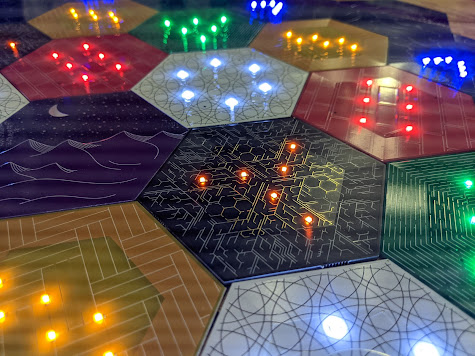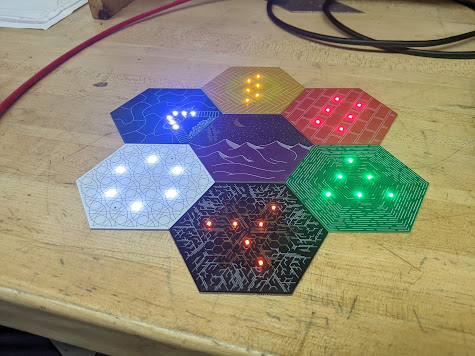Wireless Light Up Catan Board
I designed and built this awesome Catan board with hexes that light up wirelessly using an inductive coil. While I learned a lot using Altium and doing hand calcs to determine the sizing of the hexes and coil, this project turned into more of an art project when I spent 25+ hours designing the patterns on the hexes.
Close up of the Ore hexagon
Playing Catan with some of my friends
I originally got this idea from some wireless LEDs I found online and realized that the inductive coil could easily be scaled up. I did some hand calculations to determine what size coil I would need to fit a whole Catan board, the area of each Catan piece, the current and frequency in the coil and the number of turns required in each hex.
Initially I tried to use a full bridge driver to make the oscillating current required to drive the coil. This proved unsuccessful after about a dozen hours of trying to get my circuit to work I kept running into unexplained issues and fried several gate drivers, presumably due to ESD. I suspect the poor grounding on the breadboard didn't help. Luckily a $8 ZVS circuit intended to be used for an induction heater works perfectly for this.
Breadboard prototype
Ebay to the rescue! This circuit provides several hundred mA through one turn of the coil at 150kHz!
Prototype hexes being driven by the ZVS circuit
Debugging the initial design
The ZVS circuit is inherently fairly hard to derate, so the hexes in this setup are somewhat bright. In the future I plan on building an arduino based pwm circuit to decrease the brightness.
Each hex has 50 turns on the top and 50 turns on the bottom in the traces. Rather than painstakingly drawing these in altium I made a quick matlab script that exports a dxf of the required traces. Code is here: https://pastebin.com/dzabpbBH
Matlab export
I designed most of the patterns in Fusion 360 and exported them to Altium. I did this both because I don't know any real art tools, but because of the ease of creating simple geometric patterns within fusion sketches. For some hexes, such as the stars on the desert tile, I added stars directly in Altium.
Brick and desert hexes in Fusion
Overall I am very happy with how this project turned out. The only changes I would do in the future are making a derating circuit for the driving coil, and making a board that holds the ZVS circuit, limiter, and 120VAC to 12vdc stepdown converter to simplify the design. I'm also considering building the coil directly into a table and making a customer version of the cards and game pieces in addition to the hexes.
Hexes lit up for the first time
Placing a hex inside the inductive coil
Hexes off
If you want to recreate this design, the gerber files and pick and place files are located here! https://drive.google.com/drive/folders/1HvDRJJ9FP3E5ytDwdi4sVWwq_mAvehKt?usp=sharing
I ordered through JlcPCB using standard settings except for the color of each hex, and the Ore which I used gold plating for.












